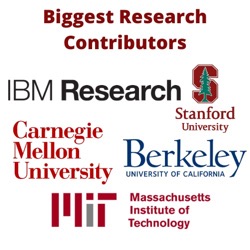By Neil C. Thompson[1], Shuning Ge, and Yash M. Sherry
Modern enterprises rely on computing power improvements and better algorithms to tackle sophisticated problems and boost productivity. Some high-level algorithms are well known (e.g., Google’s PageRank), but until recently little was known about progress in the fundamental algorithms that underpin much of computing or about their discoverers. Our research finds that U.S. universities and corporations have been the most important contributors to algorithms improvement, potentially providing an important stepping-stone for U.S. enterprises to gain competitive advantage.
In previous work, we showed that algorithm progress has been substantial – for some problems, improvements to algorithms have been orders of magnitude more important than those from computer hardware improvement (a.k.a. Moore’s Law). At a fundamental level, algorithms are public goods, so the development of the “Algorithm Commons” can benefit everyone. But, as research with open-source software has shown, just because something is a public good doesn’t mean that the first to get it don’t gain a competitive advantage. With that in mind, we map these major algorithm advances to the institutions and countries of their discoverers.
Using more than 1,000 research papers and 50 textbooks, we identify a list of ~300 algorithms that first solve a particular problem or that improve on the state-of-the-art method for that problem. These include everything from better list-sorting to the famous “traveling-salesperson” problem, where the goal is to find the quickest route around a set of cities. Of these ~300 algorithm improvements, we exclude 40% because they were brute force algorithms (naïve solutions that often formalize the problem more than offering a new discovery) or because the algorithm discoverer’s origins have been lost to history (e.g., some algorithms from ancient Greece). The remaining 180 algorithm advances yield over 400 discoverers whose countries and institutions we analyze. As Figure 1 shows, we find that 38% of algorithm improvements come from discoverers born in the U.S., but that substantially more (64%) come from discoverers working at U.S. corporations and U.S. universities. Not surprisingly, since they are public goods, most algorithms originate at public / non-profit institutions (82%).

The over-representation of U.S. companies and universities reveals that these institutions have been successful in recruiting (or developing) leaders in this field from other countries. Narrowing our analysis to the birth country of algorithm discoverers to avoid this effect, however, still shows a substantial over-representation for the United States, which could indicate that algorithm development also exhibits the “lost Einsteins” problem, where talented young people in underdeveloped communities never get to achieve their potential.
“[W]e find that 38% of algorithm improvements come from discoverers born in the U.S., but that substantially more (64%) come from discoverers working at U.S. corporations and U.S. universities. Not surprisingly, since they are public goods, most algorithms originate at public / non-profit institutions (82%).”
Over time, the U.S. dominance in algorithm development has diminished (see Figure 2), although U.S. institutions have remained important, particularly due to foreign-born researchers working there.

We also look at the type of institutions that researchers are at when they make their algorithm discoveries. We find that three private sector organizations, IBM, Bell Labs and the Rand Corporation, make the largest contributions, collectively accounting for 11% of them. Not surprisingly, the five universities with the most contributions were the ones with the highest-rated computer science programs: Stanford, MIT, the University of California at Berkeley, Carnegie Mellon, and the University of Illinois at Urbana–Champaign. Collectively these universities accounted for 19% of contributions.
The real advantage of algorithm improvement is that it provides more output without requiring more resources. Just as a productivity improvement for a business allows it to produce more outputs for a given set of inputs, an algorithmic improvement allows a computer to tackle bigger, harder problems for the same computational budget. Our research presents clear evidence of the strong role that U.S. institutions have played in building the algorithm commons, providing an important hint for a source of productivity for U.S. enterprises that has not previously been explored…but which we are now investigating.
For the original article, see Thompson, NC, Ge, S, Sherry, YM. Building the algorithm commons: Who discovered the algorithms that underpin computing in the modern enterprise? Global Strategy Journal. 2021; 11: 17– 33.
Neil Thompson is an Innovation Scholar at MIT’s Computer Science and Artificial Intelligence Lab and MIT’s Initiative on the Digital Economy. His research focuses on the pace and direction of technological change.
Shuning Ge is the senior data coordinator at Penn Development Research Initiatives. She’s been working with Dr. Thompson since 2019 with a broad interest in technological innovation and entrepreneurship.
Yash Sherry is a Masters Student at GeorgiaTech and currently associated with the SuperTech Lab at MIT CSAIL on research projects under the guidance of Dr. Thompson. His primary research focus is on latest innovations and their global impacts.
[1] Corresponding author: neil_t@mit.edu
[2] Thanks to the Tides Foundation for the funding for this project





